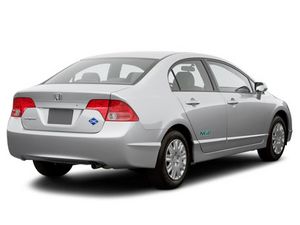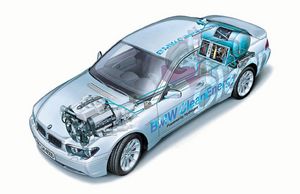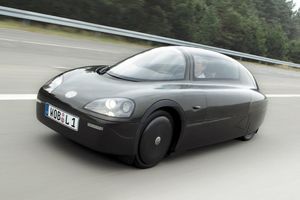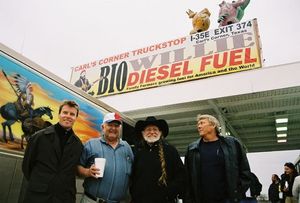.
Alternative Fuel Vehicles: Difference between revisions
205.205.28.3 (talk | contribs) |
Red marquis (talk | contribs) m (→HYDROGEN) |
||
| (68 intermediate revisions by 4 users not shown) | |||
| Line 1: | Line 1: | ||
A '''alternative-fuel vehicle''' is an [[automobile]] or other other vehicle that can typically run off an alternative type of | A '''alternative-fuel vehicle''' is an [[automobile]] or other other vehicle that can typically run off an alternative type of fuel. Many of these vehicles are also considered to be a '''flexible-fuel vehicle''' or '''dual-fuel vehicle''' which can alternate between two sources of fuel, such as diesel engined cars which can run on [[BioDiesel|biodiesel]] or natural gas vehicles which can switch to regular gasoline. | ||
==Propane== | ==Propane== | ||
Liquefied petroleum gas (LPG), also known as propane, has been used to fuel vehicles since the 1920s. Close to 9 million vehicles worldwide use propane. Cars, pickup trucks, vans, shuttles, trolleys, delivery trucks, school buses and forklifts work well using propane. Vehicles can be equipped with dedicated fueling systems designed to use only propane, or bi-fuel fueling systems that enable fueling with either propane or gasoline. All states have publicly accessible fueling stations, close to 3,000 exist. The time needed to fill a vehicle with propane is comparable to that needed for gasoline or diesel fuel. The tanks are filled to no more than 80% capacity to allow for liquid expansion in high temperatures. | |||
Aftermarket propane conversions cost on the average of $2,500. Some states offer incentives for propane. According to the '''National Propane Gas Association''', some fleets report 2-3 years longer service life and extended maintenance intervals for propane vehicles. Manufacturers and aftermarket converter companies recommend conventional maintenance intervals. Tanks that hold propane require periodic inspection and certification by a licensed inspector. Propane is a safe fuel and has a very narrow flammability range. Training is required to operate and maintain vehicles running on propane properly. | |||
===Benefits=== | ===Benefits=== | ||
| Line 11: | Line 11: | ||
* Costs less than gasoline | * Costs less than gasoline | ||
* Propane is a domestic resource | * Propane is a domestic resource | ||
* Performance is similar to those of gasoline-powered vehicles | * Performance is similar to those of gasoline-powered vehicles | ||
===Drawbacks=== | ===Drawbacks=== | ||
* Range is less than gasoline vehicles | * Range is less than gasoline vehicles | ||
* Extra storage tanks (can increase range, but at the expense of payload capacity) | * Extra storage tanks (can increase range, but at the expense of payload capacity) | ||
* Filling station scarcity | |||
==NATURAL GAS (CNG)== | ==NATURAL GAS (CNG)== | ||
[[Image:CivicGX.jpg|right|300px]] | |||
Traditionally used by fleets and heavy-duty trucks, a slow shift towards offering natural gas pumps at existing gas stations has occured. Natural Gas is available through suppliers of cryogenic liquids. Some products are even available for retail consumers to fuel up their own compressed natural gas (CNG) vehicles from their own home, using their existing gas line. Natural gas vehicles are just as safe as today's conventional gasoline and diesel engined vehicles. They use pressurized tanks, which have been designed to withstand severe impact, high external temperatures, and environmental exposure. The most popular and widely known vehicle offered for the public has been the Honda Civic GX NGV (Natural Gas Vehicle). | |||
Natural gas can cost less than gasoline and diesel (per energy equivalent gallon) however, local utility rates can vary. Purchase prices for natural gas vehicles are somewhat higher than for similar conventional vehicles. Auto manufacturers' typical price premium for a light-duty compressed natural gas vehicle can be in the range of $1,500 to $6,000. | |||
===Benefits=== | |||
* Natural gas is mostly domestically produced | |||
* Almost all the natural gas imports come from Canada | |||
* Bi-fuel NGVs offer a driving range similar to that of gasoline vehicles | |||
===Drawbacks=== | |||
* Vehicle range for CNG and LNG vehicles is less than gasoline and diesel-fueled vehicles | |||
* Payload capacity may be compromised | |||
* Filling station scarcity | |||
Vehicle range for CNG and LNG vehicles | |||
==HYDROGEN== | ==HYDROGEN== | ||
[[Image:745h.jpg|right|300px]] | |||
Hydrogen powered vehicles represent an attractive option for reducing petroleum consumption and improving air quality. Most hydrogen vehicles are powered by fuel cells that produce no air pollutants and few greenhouse gases. If fueled with pure hydrogen, fuel cells emit only heat and water as a byproduct. Hydrogen fuel cell vehicles are not yet commercially available. However, they are currently being demonstrated in several applications in fleets throughout the country. [[Honda]] has placed several prototype light-duty FCX fuel cell vehicles in city fleets. California transit agencies are testing fuel cell buses in service. [[BMW]] made the first production internal combustion hydrogen fueled vehicle, the 750hL. The next generation hydrogen internal combustion vehicle, the [[BMW 745h]], is powered by a 4.4-liter [[V8]] which can use either hydrogen or premium unleaded gasoline. Modifications from the regular gasoline [[V8]] involve the intake ports, which have additional injector valves for hydrogen. These engines come off the same production line as the other [[BMW]] [[V8]] powerplants and are installed in the vehicle using the same assembly techniques. Running on hydrogen, the 745h produces 184 [[HP]] and can achieve a top speed of 133 miles per hour. The cruising range is 190 miles. When you add this to the 400-mile range of the normal gasoline tank, the 745h has a 600 mile range. The use of sustainable hydrogen internal combustion engine technology as a more viable alternative towards [[fuel cells]] could get a boost from ongoing [[fuel cell]] development problems. On top of that, [[fuel cells]] are comparatively '''less''' efficient than utilizing an [[internal combustion engine]] to produce motive power from [[Hydrogen Fuel|hydrogen]]. Almost any gasoline engine can be adapted to use hydrogen fuel. Internal combustion engines provide various benefits compared with fuel cells, such as more power and efficiency-not to mention range and less cost, offered by gasoline or diesel power in the type of vehicles most people are accustomed to owning and driving. | |||
The downside to all these technological acheivements is that a hydrogen fuel infrastructure has yet to be built. There have been a token handful of filling stations built in Germany around airports in Munich and Berlin for publicity photos. The few Hydrogen filling stations actually open to the public can be found in Berlin, Germany, Reykjavik, Iceland and Chino, California. | |||
===Benefits=== | |||
* Zero air pollutant emissions | |||
* Few greenhouse gas emissions | |||
* Internal combustion hydrogen engines show remarkable potential | |||
* Work well in heavy duty applications (buses, construction equipment) | |||
===Drawbacks=== | |||
* Infrastructure almost non-existent | |||
* Pricing of fuel cells impractical for private plated vehicles | |||
* Fuel cell reliability not known | |||
* Poor fuel mileage (internal combustion hydrogen applications) | |||
==ELECTRICITY== | ==ELECTRICITY== | ||
Electric Vehicles (EVs) come in a variety of | [[Image:EV1.jpg|right|300px]] | ||
[[Electric Vehicles]] (EVs) come in a variety of applications. They can be light-duty delivery vehicles, heavy-duty trams or buses. Because the range of an EV is limited by weight and the type of battery used, EVs are better suited to short-distance, high-use applications such as transit buses. The largest concentration of EVs is in California and other western States. The most publicly known electric car was the General Motors EV1. It was offered for '''lease only''' from the 1996 model year. It was discontinued in 2002, [[General Motors]] citing poor sales in their decision to axe production. Other major car makers such as [[Honda]] also ceased production of their electric vehicles. Conspiracy theories suggest General Motors never really wanted the cars to take off and intentionally sabotaged their own marketing, due to fears of cannibalizing their existing models. | |||
Some manufacturers produce neighborhood electric vehicles (NEVs), which use similar battery technology and | Some manufacturers produce neighborhood electric vehicles (NEVs), which use similar battery technology and are zero emission vehicles. On the downside, most do not satisfy requirements for fleets and can only be used as token transportation on private roads. | ||
Electric vehicles use batteries and other energy storage devices to store electricity that powers the electric motor in the vehicle. Batteries must be replenished by plugging in the vehicle to some kind of outlet power source. Electricity production may contribute to air pollution, depending upon the method. | |||
Initial commercial production electric vehicles are priced from $15,000 to $40,000. Individuals and businesses that purchase electric vehicles may qualify for a federal tax credit if they meet the requirements established by the United States Internal Revenue Service in Publication 535. Many states offer additional incentives for the purchase of alternative fuel vehicles. Service requirements for EVs are fewer than those for gasoline-powered vehicles. EVs don't require traditional tuneups, oil changes, timing belts, water pumps, radiators, fuel injectors, or tailpipes. They do, of course, require battery maintenance. | |||
===Benefits=== | |||
* Zero emissions | |||
* Cost of electricity per kilowatt-hour usually compares favorably to that of gasoline | |||
* Electricity used originates from domestic resources, reducing dependence on imported oil | |||
* Fewer service requirements | |||
* Good acceleration characteristics | |||
===Drawbacks=== | |||
* Very poor range (50 to 130 miles) | |||
* Use of heating and air conditioning can make range even worse | |||
* Cost of battery replacement (estimates range from $3,000 to $6,000) | |||
* Gasoline electric hybrids are less of a compromise | |||
==BIODIESEL== | ==BIODIESEL== | ||
[[Image:VW_1Litre.jpg|300px|thumb|right|VW 1 litre experimental car can acheive 282 mpg]] | |||
[[Image:VW_1LitreII.jpg|300px|thumb|right|0.3L diesel engine produces 8.5 HP]] | |||
[[Image:biodiesel.jpg|300px|thumb|right|Willie Nelson produces his own brand of biodiesel]] | |||
Vehicles that use biodiesel include school and transit buses, refuse haulers, military support vehicles, farm equipment, and national park maintenance vehicles. Biodiesel fueling of private vehicles is becoming increasingly common. Biodiesel is available in various parts of the United States. | |||
The flashpoint of biodiesel is significantly higher than that of conventional diesel fuel, which makes the fuel safer in general. Neat biodiesel is nontoxic, biodegradable, and emits fewer carcinogens in the exhaust than conventional diesel fuel. | |||
Using biodiesel blends requires little or no engine modification and maintenance costs are comparable to those of conventional diesel vehicles. Neat biodiesel costs range from $1.95 to $3 per gallon, depending on the feedstock and market. In general, B20 will cost $.20 to $.40 per gallon more than conventional diesel. All diesel fuels require special measures for use in cold temperatures. Biodiesel has a higher cloud point than conventional diesel. However, the same strategies used to ensure operability of conventional diesel fuels in wintertime will also work for biodiesel blends. These include the use of additives and blending with number 1 diesel fuel. | |||
The strength of biodiesel is that it can reduce emissions in '''any''' conventional diesel engined vehicle. The increased lubricity of the fuel also promotes engine longevity. Biodiesel fuel reduces the amount sooty black smoke common to older diesel engined vehicles. | |||
===Benefits=== | |||
* Reduced emissions | |||
* Biodiesel is domestically produced (reduces dependance on imported oil) | |||
* Helps the agricultural sector | |||
* Biodiesel is renewable (made from domestically grown crops like soybeans and mustard seed) | |||
* Lubricity is improved over conventional diesel fuel | |||
* Performance, [[HP|horsepower]], torque, acceleration, cruising speed, fuel economy similar to diesel | |||
===Drawbacks=== | |||
* Energy content of B100 is 10%-12% lower than conventional diesel | |||
==External Links== | ==External Links== | ||
[http://www.eere.energy.gov/afdc/afv/models.html U.S. Department of Energy - Official Site] | [http://www.eere.energy.gov/afdc/afv/models.html U.S. Department of Energy - Official Site] | ||
[http://www.epa.gov/ U.S. Environmental Protection Agency - Official Site] | |||
[http://www.npga.org/i4a/pages/index.cfm?pageid=1 National Progane Gas Association] | |||
Latest revision as of 16:25, 25 September 2009
A alternative-fuel vehicle is an automobile or other other vehicle that can typically run off an alternative type of fuel. Many of these vehicles are also considered to be a flexible-fuel vehicle or dual-fuel vehicle which can alternate between two sources of fuel, such as diesel engined cars which can run on biodiesel or natural gas vehicles which can switch to regular gasoline.
Propane
Liquefied petroleum gas (LPG), also known as propane, has been used to fuel vehicles since the 1920s. Close to 9 million vehicles worldwide use propane. Cars, pickup trucks, vans, shuttles, trolleys, delivery trucks, school buses and forklifts work well using propane. Vehicles can be equipped with dedicated fueling systems designed to use only propane, or bi-fuel fueling systems that enable fueling with either propane or gasoline. All states have publicly accessible fueling stations, close to 3,000 exist. The time needed to fill a vehicle with propane is comparable to that needed for gasoline or diesel fuel. The tanks are filled to no more than 80% capacity to allow for liquid expansion in high temperatures.
Aftermarket propane conversions cost on the average of $2,500. Some states offer incentives for propane. According to the National Propane Gas Association, some fleets report 2-3 years longer service life and extended maintenance intervals for propane vehicles. Manufacturers and aftermarket converter companies recommend conventional maintenance intervals. Tanks that hold propane require periodic inspection and certification by a licensed inspector. Propane is a safe fuel and has a very narrow flammability range. Training is required to operate and maintain vehicles running on propane properly.
Benefits
- 60% fewer ozone-forming emissions (CO and NOx) than reformulated gasoline
- 98% reduction in the emissions of toxics (compared to regular gasoline)
- Costs less than gasoline
- Propane is a domestic resource
- Performance is similar to those of gasoline-powered vehicles
Drawbacks
- Range is less than gasoline vehicles
- Extra storage tanks (can increase range, but at the expense of payload capacity)
- Filling station scarcity
NATURAL GAS (CNG)
Traditionally used by fleets and heavy-duty trucks, a slow shift towards offering natural gas pumps at existing gas stations has occured. Natural Gas is available through suppliers of cryogenic liquids. Some products are even available for retail consumers to fuel up their own compressed natural gas (CNG) vehicles from their own home, using their existing gas line. Natural gas vehicles are just as safe as today's conventional gasoline and diesel engined vehicles. They use pressurized tanks, which have been designed to withstand severe impact, high external temperatures, and environmental exposure. The most popular and widely known vehicle offered for the public has been the Honda Civic GX NGV (Natural Gas Vehicle).
Natural gas can cost less than gasoline and diesel (per energy equivalent gallon) however, local utility rates can vary. Purchase prices for natural gas vehicles are somewhat higher than for similar conventional vehicles. Auto manufacturers' typical price premium for a light-duty compressed natural gas vehicle can be in the range of $1,500 to $6,000.
Benefits
- Natural gas is mostly domestically produced
- Almost all the natural gas imports come from Canada
- Bi-fuel NGVs offer a driving range similar to that of gasoline vehicles
Drawbacks
- Vehicle range for CNG and LNG vehicles is less than gasoline and diesel-fueled vehicles
- Payload capacity may be compromised
- Filling station scarcity
HYDROGEN
Hydrogen powered vehicles represent an attractive option for reducing petroleum consumption and improving air quality. Most hydrogen vehicles are powered by fuel cells that produce no air pollutants and few greenhouse gases. If fueled with pure hydrogen, fuel cells emit only heat and water as a byproduct. Hydrogen fuel cell vehicles are not yet commercially available. However, they are currently being demonstrated in several applications in fleets throughout the country. Honda has placed several prototype light-duty FCX fuel cell vehicles in city fleets. California transit agencies are testing fuel cell buses in service. BMW made the first production internal combustion hydrogen fueled vehicle, the 750hL. The next generation hydrogen internal combustion vehicle, the BMW 745h, is powered by a 4.4-liter V8 which can use either hydrogen or premium unleaded gasoline. Modifications from the regular gasoline V8 involve the intake ports, which have additional injector valves for hydrogen. These engines come off the same production line as the other BMW V8 powerplants and are installed in the vehicle using the same assembly techniques. Running on hydrogen, the 745h produces 184 HP and can achieve a top speed of 133 miles per hour. The cruising range is 190 miles. When you add this to the 400-mile range of the normal gasoline tank, the 745h has a 600 mile range. The use of sustainable hydrogen internal combustion engine technology as a more viable alternative towards fuel cells could get a boost from ongoing fuel cell development problems. On top of that, fuel cells are comparatively less efficient than utilizing an internal combustion engine to produce motive power from hydrogen. Almost any gasoline engine can be adapted to use hydrogen fuel. Internal combustion engines provide various benefits compared with fuel cells, such as more power and efficiency-not to mention range and less cost, offered by gasoline or diesel power in the type of vehicles most people are accustomed to owning and driving.
The downside to all these technological acheivements is that a hydrogen fuel infrastructure has yet to be built. There have been a token handful of filling stations built in Germany around airports in Munich and Berlin for publicity photos. The few Hydrogen filling stations actually open to the public can be found in Berlin, Germany, Reykjavik, Iceland and Chino, California.
Benefits
- Zero air pollutant emissions
- Few greenhouse gas emissions
- Internal combustion hydrogen engines show remarkable potential
- Work well in heavy duty applications (buses, construction equipment)
Drawbacks
- Infrastructure almost non-existent
- Pricing of fuel cells impractical for private plated vehicles
- Fuel cell reliability not known
- Poor fuel mileage (internal combustion hydrogen applications)
ELECTRICITY
Electric Vehicles (EVs) come in a variety of applications. They can be light-duty delivery vehicles, heavy-duty trams or buses. Because the range of an EV is limited by weight and the type of battery used, EVs are better suited to short-distance, high-use applications such as transit buses. The largest concentration of EVs is in California and other western States. The most publicly known electric car was the General Motors EV1. It was offered for lease only from the 1996 model year. It was discontinued in 2002, General Motors citing poor sales in their decision to axe production. Other major car makers such as Honda also ceased production of their electric vehicles. Conspiracy theories suggest General Motors never really wanted the cars to take off and intentionally sabotaged their own marketing, due to fears of cannibalizing their existing models.
Some manufacturers produce neighborhood electric vehicles (NEVs), which use similar battery technology and are zero emission vehicles. On the downside, most do not satisfy requirements for fleets and can only be used as token transportation on private roads.
Electric vehicles use batteries and other energy storage devices to store electricity that powers the electric motor in the vehicle. Batteries must be replenished by plugging in the vehicle to some kind of outlet power source. Electricity production may contribute to air pollution, depending upon the method.
Initial commercial production electric vehicles are priced from $15,000 to $40,000. Individuals and businesses that purchase electric vehicles may qualify for a federal tax credit if they meet the requirements established by the United States Internal Revenue Service in Publication 535. Many states offer additional incentives for the purchase of alternative fuel vehicles. Service requirements for EVs are fewer than those for gasoline-powered vehicles. EVs don't require traditional tuneups, oil changes, timing belts, water pumps, radiators, fuel injectors, or tailpipes. They do, of course, require battery maintenance.
Benefits
- Zero emissions
- Cost of electricity per kilowatt-hour usually compares favorably to that of gasoline
- Electricity used originates from domestic resources, reducing dependence on imported oil
- Fewer service requirements
- Good acceleration characteristics
Drawbacks
- Very poor range (50 to 130 miles)
- Use of heating and air conditioning can make range even worse
- Cost of battery replacement (estimates range from $3,000 to $6,000)
- Gasoline electric hybrids are less of a compromise
BIODIESEL
Vehicles that use biodiesel include school and transit buses, refuse haulers, military support vehicles, farm equipment, and national park maintenance vehicles. Biodiesel fueling of private vehicles is becoming increasingly common. Biodiesel is available in various parts of the United States.
The flashpoint of biodiesel is significantly higher than that of conventional diesel fuel, which makes the fuel safer in general. Neat biodiesel is nontoxic, biodegradable, and emits fewer carcinogens in the exhaust than conventional diesel fuel.
Using biodiesel blends requires little or no engine modification and maintenance costs are comparable to those of conventional diesel vehicles. Neat biodiesel costs range from $1.95 to $3 per gallon, depending on the feedstock and market. In general, B20 will cost $.20 to $.40 per gallon more than conventional diesel. All diesel fuels require special measures for use in cold temperatures. Biodiesel has a higher cloud point than conventional diesel. However, the same strategies used to ensure operability of conventional diesel fuels in wintertime will also work for biodiesel blends. These include the use of additives and blending with number 1 diesel fuel.
The strength of biodiesel is that it can reduce emissions in any conventional diesel engined vehicle. The increased lubricity of the fuel also promotes engine longevity. Biodiesel fuel reduces the amount sooty black smoke common to older diesel engined vehicles.
Benefits
- Reduced emissions
- Biodiesel is domestically produced (reduces dependance on imported oil)
- Helps the agricultural sector
- Biodiesel is renewable (made from domestically grown crops like soybeans and mustard seed)
- Lubricity is improved over conventional diesel fuel
- Performance, horsepower, torque, acceleration, cruising speed, fuel economy similar to diesel
Drawbacks
- Energy content of B100 is 10%-12% lower than conventional diesel
External Links
U.S. Department of Energy - Official Site




